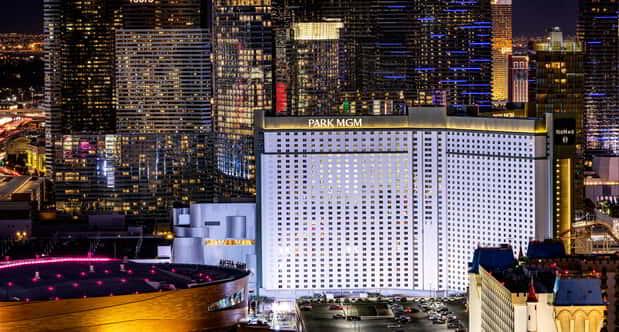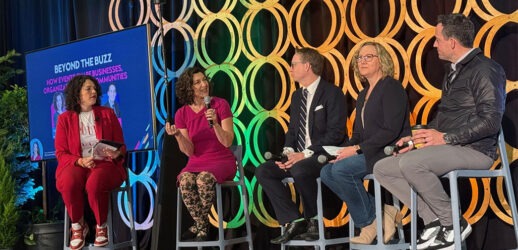As small- to mid-size meetings are coming back fast, how are meeting professionals really managing the challenges of sustainability, supply chain issues and staffing? “There is a gap between what people are saying and what we are seeing,” said IACC CEO Mark Cooper. At IACC Americas Connect, the group’s first centralized, live event in three years, he plans to build on Meetings of the Future research and model the three pillars addressed in the group’s signature report—Community, People and Environment.
“Meetings of the Future has always been about getting the smartest people on stage along with the opinions of our members and working it out,” he said. That is just what the agenda calls for at Park MGM Las Vegas May 23-25.
CSR in Action
Now, about that gap. When IACC surveyors ask meeting professionals if they consider sustainability in their RFPs, almost to a person they say, “Yes.” But in the Spring 2022, Meeting Rooms of the Future Barometer survey of global small and medium-size venues, only 46% said they are receiving increased requests to provide social responsibility or environmental credentials and only 13% are being asked to measure the carbon used to run their meetings.
“We could be in the adoption phase and the train is coming down the track, but hasn’t arrived yet, or it could be something else.”
“Yes, it is important, but no, it is not flowing through,” Cooper said. “We could be in the adoption phase and the train is coming down the track, but hasn’t arrived yet, or it could be something else. We need to understand what that means for the future.” He speculated the disconnect could be because meeting professionals have gotten to the point where they aren’t asking because they are just expecting sustainability measures to be in place. “We need to know that, too,” he said.
Experts being tapped to share insights include partners at Events Industry Council, Oxford Economics and Cvent.
IACC is also partnering with MGM Resorts while in Las Vegas to source talent locally, starting with author Vital Germaine leading attendees through an exercise to innovate their business practices for a post-Covid era. MGM is opening the doors behind the scenes to show off their solar array and leadership role in managing their environmental impact.
F&B is being designed around zero waste. And the Global Copper Skillet Finale on the last day has become a coveted cook-to-the-finish competition to name the best venue chef in the world. “We are embracing the best in building a sustainable and equitable workplace environment,” Cooper said.
Streaming Under the Microscope
Similarly, everyone assumed that hybrid meetings would be the future, but in reality most companies have gone straight to in-person. According to the Spring Barometer survey, 81% of venues have made some or a major investment in virtual technology and 56% of events happening in their spaces in 2021 have a virtual component.
Read expert predictions for 2022 meetings.
IACC’s research and sessions aim to filter out the reality from the platitudes. “We need to focus on the gaps in intelligence to learn what is really happening,” Cooper said. He is particularly interested in the trends for smaller conferences and meetings of under 100 or even under 50 people, which is the bread and butter of events held in IACC facilities. “Some of this may be happening at large venues and hasn’t filtered down yet,” he said. “It is valuable to understand what is coming.”
“As a global organization, IACC looks at trends across the world as that can inform what the future will look like in other countries.”
One of the trends hitting across the globe is a tight labor market. Because small venues have been the fastest to come back, they have had to build their workforce back faster than larger venues. Many were able to maintain their staff and that has made it easier. But they are sensitive to issues in the supply chain and workforce, Cooper reported.
“We are at risk of trying to bounce back to where we were before. But what if the reality is we are never going back to the way we staffed hotels and restaurants in the past because there isn’t the ability or desire to do so?” Cooper asked.
That could mean automating more and thinking differently. The idea is to use humans where people can make a difference, he said.
An example is when inquiries and RFPs have gone up 20% and staff availability is down 20%, venues can no longer respond to everyone individually. “Customers have digitalized how they are sending RFPs and we need to automate the ability for them to book and schedule small meetings themselves,” he reasoned. For an event of under 120 people, perhaps a bespoke, a la carte composition for every occurrence is not necessary or advantageous. A conference can be pre-packaged, and the value is built in.
Automated Planning
According to IACC’s most recent survey, 35% of venues in the Americas plan to automate services for meeting attendees to address staffing shortages compared to half of venues in Australia.
“Think of automation not as a threat or a solution to a problem that should be solved another way, but as an evolution now that we are being forced to take a risk,” Cooper said. “It is going to be another fast-paced five years,” he concluded.
Takeaways
Cooper hopes people take away a personal commitment to taking a calculated risk. “We want to use everything special about coming back live, infused with the three pillars, so people leave informed and enthused to make a commitment to try something new,” he said.




